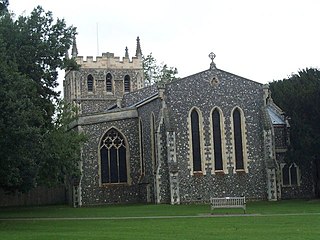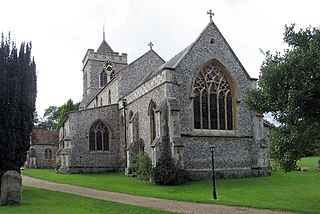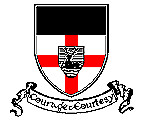
Royston is a town and civil parish in the District of North Hertfordshire and county of Hertfordshire in England.

Hertford is the county town of Hertfordshire, England, and is also a civil parish in the East Hertfordshire district of the county. The parish had a population of 26,783 at the 2011 census.

Baldock is a historic market town in the local government district of North Hertfordshire in the ceremonial county of Hertfordshire, England, where the River Ivel rises. It lies 33 miles (53 km) north of London, 15 miles (24 km) southeast of Bedford, and 14 miles (23 km) north northwest of the county town of Hertford. Nearby towns include Royston to the northeast, Letchworth and Hitchin to the southwest and Stevenage to the south.

North Hertfordshire is a local government district in Hertfordshire, England. Its council is based in Letchworth.

Hinxworth is a village and civil parish in North Hertfordshire, England. It sits just off the Great North Road between Baldock and Biggleswade. It has a village hall, a park, a pub, a small church, a bus stop and a post box. The population at the 2011 Census was 313.

Therfield is both a small village of approximately 4,761 acres (19 km²) and a civil parish which sits upon the chalk range, three miles southwest of Royston, and six miles (10 km) northeast of Baldock and within the English county of Hertfordshire.

Ashwell is a village and civil parish in Hertfordshire situated 4 miles (6 km) north-east of Baldock.

Royston Cave is an artificial cave located in Katherine's Yard, Melbourn Street, Royston, England. It is located beneath the crossroads formed by Ermine Street and the Icknield Way. It is protected as both a scheduled ancient monument and Grade I listed building. It has been speculated that it was used by the Knights Templar, who founded nearby Baldock, but this is unlikely, despite its enormous popular appeal. There are numerous theories about the Cave covering Freemasons and Templars as well as possibilities that the Cave was a prison or an anchorite cell. However, none of these theories have enough hard evidence to warrant their being adopted by the Cave Trust. It is open to the public in the summer months on Saturday, Sunday and Bank Holiday afternoons between Easter and October.

Melbourn Rural District was a rural district in Cambridgeshire, England, from 1894 to 1934.

Hadham Rural District was a rural district in Hertfordshire, England from 1894 to 1935, covering an area in the east of the county.

The Knights Templar School is a co-educational secondary school with academy status located in the market town of Baldock in North Hertfordshire, England. In a February 2006 Ofsted report, the school was described as "outstanding", one of only eight secondary schools in Hertfordshire to be so recognised. It retained its "outstanding" status following a further Ofsted inspection in February 2009. The Knights Templar School gained academy status on 1 April 2011. Following an Ofsted inspection in October 2012 the school was categorised as "good" against a newer, far more demanding Inspection framework.
The history of the Knights Templar in England began when the French nobleman Hughes de Payens, the founder and Grand Master of the order of the Knights Templar, visited the country in 1128 to raise men and money for the Crusades.

The Church of St Mary the Virgin is a parish church of the Church of England in Baldock in Hertfordshire. Dedicated to the Virgin Mary, the original church on the site dated to about 1150 and was built by the Knights Templar before being largely rebuilt in about 1330 by the Knights Hospitaller. It is a Grade I listed building.
The town of Biggleswade in Bedfordshire, England was administered as a Local Government District from 1892 to 1894 and an Urban District from 1894 to 1974.
The Greneway Middle School was a middle school in Royston, Hertfordshire, England, which has been combined with Roysia Middle School and Meridian School to form King James Academy Royston.
The Comet is a weekly newspaper covering the English towns of Stevenage, Hitchin, Letchworth and Baldock, as well as the surrounding villages in north Hertfordshire and south-east Bedfordshire. It is based in Stevenage and part of the Archant group. The vast majority of its copies are delivered locally or picked up as a free newspaper, but it is also sold. It is published each Thursday in three editions—one concentrates on the Stevenage area, another focuses on Hitchin and a third pays particular attention to Letchworth and Baldock. Nick Gill has been editor since January 2017; previous permanent editors were Darren Isted (2002–14) and John Francis, who retired in June 2016.

Holy Trinity Church is the parish church for the village of Weston in Hertfordshire. The church building stands to the south-east of the village on high ground, and is built of flint and coursed ironstone rubble. It was Grade I listed in 1968. In the churchyard is the supposed grave of the giant Jack o'Legs.
The 2019 North Hertforshire District Council election took place on 2 May 2019 to elect 16 of the 49 members of North Hertfordshire District Council in England. This was on the same day as other local elections around the country. Heading into the election, the Conservative Party held a 4-seat majority. Although they still had 6 seats more than any other party after the result of the election, they lost their majority.

The Old Town Hall is a municipal building in the High Street, Hemel Hempstead, Hertfordshire, England. The town hall, which was the meeting place of Hemel Hempstead Borough Council, is a Grade II listed building.
Ashwell Rural District was a rural district in Hertfordshire, England from 1894 to 1935, covering an area in the north-east of the county.















